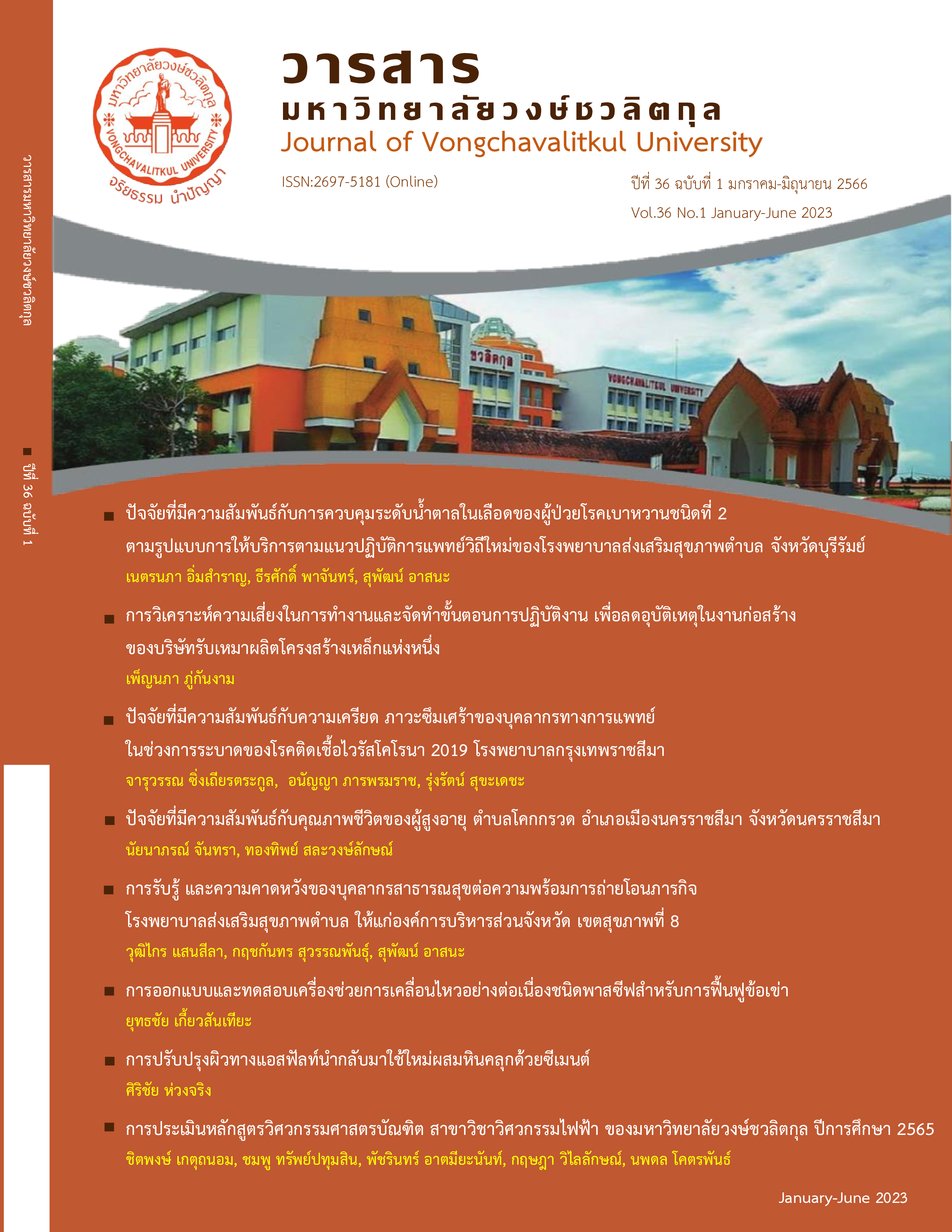Design and Testing the Continuous Passive Motion Device for Knee Rehabilitation
Main Article Content
Abstract
Objective: The continuous passive motion device is used to increase knee range of motion after a total knee arthoplasty. Since the restricted range of motion affects functional activities, this research work aimed to the design, construct and test the continuous passive motion device for knee rehabilitation after surgery. The chosen design incorporates a slider crank linkage mechanism as it offers a range of motion similar to the natural variation of the knee angle during activities in daily life.
Methods: The continuous passive motion device in this research consisted of a 5.4 V 1.4 A DC step motor, a microcontroller, a motor driver, a slider crank linkage mechanism part, and a ball screw. A ball screw with a pitch of 0.01 m and 0.5 m length was driven by motor. The motor was commanded from motor driver controller and micro controller. The device enabled extension and flexion of the knee joint within the range of motion from 0 degree to 90 degree at speeds of 5, 6, and 7 mm/s. The digital goniometer was installed on the pivot joint on the linkage mechanism to measure the knee angle movement compared with the predetermined angle movement at that angle to find the percentage of error of the knee angle movement.
Results: From the test, it was found that the continuous passive motion device can function as intended and it was able to move according to the preset angle and speed accurately. The percentage of error of the movement and velocity were in between 0.05 to 2.70 percentages and 0.20 to 1.60 percentages, respectively.
Article Details

This work is licensed under a Creative Commons Attribution-NonCommercial-NoDerivatives 4.0 International License.
References
การเชื่อมต่อไมโครคอนโทรลเลอร์กับบอร์ดขับเคลื่อนมอเตอร์. (2665). สืบค้น 8 เมษายน พ.ศ.2565. จาก https://www.modulemore.com/ product/1246
กรดา ผึ่งผาย, วริษฐา กังธีรวัฒน์, และ ระพีพัฒน์ นาคบุญนำ. (2562). การใช้เครื่องช่วยการเคลื่อนไหวข้อเข่าอย่างต่อเนื่องในผู้ป่วยผ่าตัดเปลี่ยนข้อเข่าเทียม. วารสารเวชบันทึกศิริราช, 12(2), 116-121. http://dx.doi.org/10. 33192/Simedbull.2019.19
กฤษกมล สิทธิทูล. (2564). การผ่าตัดเปลี่ยนข้อเข่าทั้งหมด. สืบค้น 8 เมษายน พ.ศ. 2565. https://www.sanook.com/ health/29477/
กัตติกา ภูมิพิทักษ์กุล. (2535). เวชศาสตร์ฟื้นฟูในการเปลี่ยนข้อเข่าเทียม. วารสารเวชศาสตร์ฟื้นฟูสาร, 2(2), 7 – 11.
ขวัญสุวีย์ อภิจันทรเมธากุล, สุวรรณี สร้อยสงค์, และ บุศริน เอี่ยวสีหยก. (2561). การพยาบาลผู้ป่วยโรคข้อเข่าเสื่อมที่ได้รับการผ่าตัดเปลี่ยนข้อเข่า. วารสารวิทยาลัยพยาบาลพระปกเกล้า จันทบุรี, 29(1), 223 – 238.
คมสันต์ มุ่ยสี, กฤษณะ จันทสิทธิ์, และศรายุทธ์ จิตรพัฒนากุล. (2563). การพัฒนาอุปกรณ์ช่วยการเคลื่อนไหวส่วนข้อเท้า ข้อเข่าและข้อสะโพก. วารสารก้าวทันโลกวิทยาศาสตร์, 20(1), 90 – 104.
จิดาภา รัตนโรจน์พันธ์. (2556). การออกแบบและพัฒนาเครื่องช่วยการเคลื่อนไหวข้อเข่าแบบต่อเนื่องด้วยการควบคุมแบบหน้าจอสัมผัส (วิทยานิพนธ์ปริญญา วิทยาศาสตรมหาบัณฑิต). มหาวิทยาลัยเทคโนโลยีพระจอมเกล้าพระนครเหนือ, กรุงเทพฯ.
ณัฐสุรางค์ บุญจันทร์. (2552). ปวดข้อ ข้อเสื่อมและการประยุกต์กระบวนการพยาบาล. (พิมพ์ครั้งที่ 2). กรุงเทพฯ: เอ็น พี เพรส.
พงษ์สุข ธราพงษ์พันธ์ และ สุเมธ อ่ำชิต. (2558). การพัฒนาเครื่องช่วยการเคลื่อนไหวข้อเข่าอย่างต่อเนื่องอัจฉริยะ. รายงานสืบเนื่องการประชุมวิชาการเสนอผลงานวิจัยระดับบัณฑิตศึกษาแห่งชาติครั้งที่ 34 (น. 239-248). ขอนแก่น: บัณฑิตวิทยาลัย มหาวิทยาลัยขอนแก่น. https://gsbooks.gs.kku.ac.th/58/ the34th/pdf/PMO11.pdf
นงพิมล นิมิตรอานันท์. (2557). สถานการณ์ทางระบาดวิทยาและการประเมินความเสี่ยงโรคข้อเข่าเสื่อมในคนไทย.วารสารพยาบาลทหารบก, 15(3), 185 -194.
โรงพยาบาลร้อยเอ็ด. (2563). ราคากลางเครื่องช่วยการเคลื่อนไหลข่อเข่าแบบต่อเนื่อง. สืบค้น 8 เมษายน พ.ศ.2565. http://www.reh.go.th/web2/ attachments/article/3592/ราคากลางเครื่องช่วยการเคลื่อนไหวข้อเข่า.pdf
สำนักการแพทย์ กรุงเทพมหานคร. (2564). โรคข้อเข่าเสื่อม. สืบค้น 8 เมษายน พ.ศ.2565. www.msdbangkok.go.th/ healthconnor_Osteoarthritis%20of%20the%20Knee.htm
Golgouneh, A., Bamshad, A., Tarvirdizadeh, B., & Farzam Tajdari, F. (2016). Design of a New, Light and Portable Mechanism for Knee CPM Machine with a User-Friendly Interface. Conference: 2016 Artificial Intelligence and Robotics (IRANOPEN). https://DOI:10.1109/ RIOS.2016.7529498
Ho, H. J., & Chen, T. C. (2006). Hybrid CPM/CAM Physiotherapy Device by Use of Active Feedback Control Loop. First International Conference on Innovative Computing, Information and Control - Volume I (ICICIC'06). 30 Aug.-1 Sept. 2006. Beijing, China. https://DOI: 10.1109/ICICIC.2006.292
Luttgens, K. & Hamilton, N. (1997). Kinesiology: Scientific Basis of Human Motion (9th Ed). Madison, WI: Brown & Benchmark.
Vexta. (2022). PH268-21 PDF Datasheet – Stepping Motor. Retrieved April 8, 2022. from http://www.datasheetcafe. com/ ph268-21-pdf-26815/.
Yang, X., Li, G. H., Wang, H. J., & Wang, C. Y. (2019). Continuous Passive Motion After Total Knee Arthroplasty: A Systematic Review and Meta-analysis of Associated Effects on Clinical Outcomes. Archives of Physical Medicine and Rehabilitation, 100(9), 1763–1778. https://DOI:10.1016/j.apmr.2019.02.001. ISSN 0003-9993. PMID 30831093.


